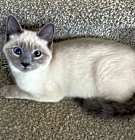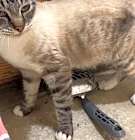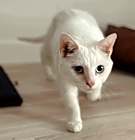Abyssinian cats stop growing around one year of age. They reach most of their adult size by around eight to 12 months but can continue to fill out and develop muscle tone until they are about 18 months old.
Abyssinian
Breed Type: African
Common nicknames: Aby
Coat: Short-haired
Hypoallergenic: No, they will likely trigger allergies.
Temperament: Friendly, sociable, energetic, playful
Life expectancy: 12-17 years
Color & patterns:

Abyssinians aren’t only one of the oldest cat breeds (their history can be traced back to ancient Egypt) but are also one of the most striking and elegant cat breeds out there. With their slender and muscular builds, ticked coats, and large ears, it’s hard not to be captivated by their beauty. Plus, their short, easy-to-maintain coats mean you won’t have to spend hours grooming them. But looks aren’t everything, and the Abyssinian has plenty of personality to match. They are known for being intelligent, loyal to their humans, affectionate, and playful — all qualities that make them great companions for those who want an active and engaged pet. In fact, these cats are often described as “dog-like” due to their endless curiosity and high energy levels. If you’re looking for a cat who is always up for a good game or cuddle session, the Abyssinian is the perfect choice.
Abyssinian characteristics
Learn about about Abyssinian basics like their fur colors, shedding levels, how much grooming they need, and other Abyssinian facts.
Average height
8-10 inches (20.3-25.4cm)
Average weight
6-12 pounds (2.7-5.4 kg)
Average lifespan
12-17 years
Good with other cats
Good with dogs
Affection
Shedding
Health
Exercise needs
How long do Abyssinian cats live?
Abyssinian cats typically live to around 15 years. However, an individual cat’s genetics, diet, exercise, and access to veterinary care are important in determining their lifespan.
How much do Abyssinian cats shed?
Abyssinian cats have short coats that do shed, but shedding is manageable with regular grooming. Abyssinians are moderate shedders compared to long-haired breeds or breeds with denser coats. Brushing can help remove loose hair, keeping them healthy and shiny.
What eye colors can an Abyssinian have?
An Abyssinian’s eye color is usually gold but can also be green, copper, or hazel.
Can Abyssinian cats be black?
Yes, Abyssinian cats can be black, but it is rare. The recognized coat colors for Abyssinians are ruddy, cinnamon, blue, and fawn.
What color coats can Abyssinian cats have?
The traditional coat colors for Abyssinian cats include ruddy (a ruddy brown base with black ticking), cinnamon (rich, warm, red base with chocolate-brown ticking), blue (a warm beige base with slate-blue ticking), and fawn (warm rose-beige base with light brown ticking). There are also variations and dilute versions recognized in some breed standards, such as lilac and silver versions of the standard colors.
Abyssinian cats are known for their distinctive ticked coats, which have a warm, glowing appearance due to the individual hairs being banded with different colors.
How big do Abyssinian cats get?
Abyssinian cats are medium-sized, typically weighing between six to 12 pounds. Males are usually larger than females. They have a slender, muscular build with long legs and a relatively long tail, giving them a graceful and athletic appearance.
Abyssinian temperament
Learn about about the Abyssinian temperament and how well they fit into your lifestyle, home environment, and family.
Are Abyssinian cats cuddly?
No, Abyssinian cats are not the most cuddly cats, but they are affectionate and loving. These kitties are more likely to show affection through interactive play, following their people around, and hanging out close by rather than loafing for extended cuddle sessions. However, individual personalities can vary; some Abyssinians enjoy cuddling and being close to their pet parents more than others.
Are Abyssinian cats good with dogs?
Yes, Abyssinian cats are usually good with dogs, especially if they are raised together or introduced to each other properly. Abyssinians are social and adaptable cats who can form relationships with calm and friendly dogs.
Are Abyssinian cats good with other cats?
Yes, Abyssinian cats are usually good with other cats, especially if they are introduced properly and given time to adjust to each other. They are social and can form strong bonds with other cats in the household, often enjoying interactive play and companionship. Individual personalities can vary, so some Abyssinians might prefer to be the only cat in the household.
Are Abyssinian cats vocal?
No, Abyssinian cats are not as vocal as some other breeds, like the Siamese. They often express themselves with soft chirps, trills, and purrs rather than loud meows.
Are Abyssinian cats friendly?
Yes, Abyssinian cats are friendly and sociable. They are typically very affectionate and enjoy being around people. Abyssinians tend to get along well with other pets and children, making them a good choice for families.
Are Abyssinian cats good hunters?
Yes, Abyssinian cats are good hunters. They have a strong prey drive and are naturally curious and agile, which contributes to their hunting abilities. However, hunting prowess can vary individually, and some Abyssinians might prefer to play rather than hunt.
Are Abyssinian cats good lap-cats?
No, Abyssinian cats are not good lap-cats in the traditional sense. They are known for their active and playful nature, so they might not always enjoy sitting still for long periods. However, they are loving and enjoy spending time with their human companions in their own way. Many Abyssinians show affection by sitting near you, leaning against you, or occasionally sitting on your lap for short periods, especially when they are tired or seeking warmth.
Are Abyssinian cats active?
Yes, Abyssinian cats are active. They are playful, curious, and enjoy interactive activities. Abyssinians thrive on mental and physical stimulation, so they appreciate toys, climbing structures, and games that engage their natural agility and intelligence. Providing regular play sessions and enrichment activities helps keep them happy and healthy.
Abyssinian health
Learn about about the Abyssinian health outlook and what diseases they may be prone to at various stages of their life.
Can Abyssinian cats go outside?
It’s recommended that all cats remain indoors as outdoor environments can pose risks such as traffic, predators, and disease. If you decide to allow your Abyssinian outside, always supervise them closely to ensure they stay safe and don’t wander too far. Providing stimulating indoor environments, such as climbing structures, toys, and interactive play, can help satisfy an Abyssinian’s need for activity and exploration without exposing them to outdoor risks.
Do you need to groom an Abyssinian cat?
Yes, you need to groom an Abyssinian cat, but it is relatively straightforward. Weekly brushing with a soft-bristled brush or grooming mitt removes loose hair, distributes natural oils, and reduces shedding. Also, trim your Abyssinian’s nails regularly to prevent them from becoming too long and causing discomfort or snagging on furniture or carpet.
Are Abyssinian cats hypoallergenic?
No, Abyssinian cats are not hypoallergenic. Although no cat breed is completely hypoallergenic, some breeds seem to produce fewer allergens than others. Abyssinians shed less than some other breeds and have short coats, so they might spread fewer allergens than long-haired breeds. However, individual reactions to cats vary. Individuals with cat allergies should spend time around adult Abyssinians before bringing one home.
Are Abyssinian cats healthy?
Yes, Abyssinian cats are healthy. Like all breeds, Abyssinians are prone to certain hereditary health issues, including:
Renal amyloidosis: A hereditary condition where abnormal protein deposits can affect the kidneys.
Pyruvate kinase deficiency (PK deficiency): An inherited enzyme deficiency that can cause anemia in affected cats.
Progressive retinal atrophy (PRA): A genetic disorder that can lead to progressive vision loss.
Abyssinian history
Learn about where this Abyssinian came from!
Where are Abyssinian cats from?
Abyssinian cats are believed to have originated in ancient Ethiopia, historically known as Abyssinia, which is where they get their name. However, the breed we know today was developed in Britain. The first documented Abyssinian was brought to England by a British soldier returning from Abyssinia in the 19th century. The breed didn’t reach North America until the early 1900s.
Are Abyssinian cats rare?
Yes, Abyssinian cats are rare compared to more common cat breeds like the Persian or the Siamese. However, their rarity can vary by region, with some areas having more Abyssinians available than others.
Find Abyssinian kittens near you
Adopting an Abyssinian
We don't see any Abyssinians available for adoption in your exact location or cities near you, but here are some adorable similar breeds in Columbus, OH.

Luna
Siamese
Female, 4 mos
Columbus, OH
Good with dogs
Good with cats
Spayed or Neutered
Shots are up-to-date

Teddy
Balinese
Male, young
Sunbury, OH
Good with dogs
Good with cats
House-trained
Spayed or Neutered
Shots are up-to-date

Scarlet
Siamese
Female, adult
Sunbury, OH
Good with dogs
Good with cats
House-trained
Shots are up-to-date

Cocononuts
Siamese Domestic Shorthair
Male, 3 yrs
Granville, OH
Good with dogs
Good with cats
Spayed or Neutered

Luna
Siamese
Female, 4 mos
Columbus, OH
Good with dogs
Good with cats
Spayed or Neutered
Shots are up-to-date

Teddy
Balinese
Male, young
Sunbury, OH
Good with dogs
Good with cats
House-trained
Spayed or Neutered
Shots are up-to-date

Scarlet
Siamese
Female, adult
Sunbury, OH
Good with dogs
Good with cats
House-trained
Shots are up-to-date

Cocononuts
Siamese Domestic Shorthair
Male, 3 yrs
Granville, OH
Good with dogs
Good with cats
Spayed or Neutered







